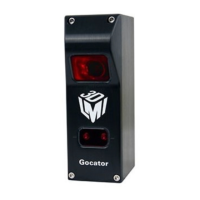Gocator Snapshot Sensors: User Manual
Protocols • 392
Field Type Offset Description
gatewayAddress[4] byte 73 Gateway address.
reserved[12] byte 77 Reserved.
controlPort 16u 89 Control channel port.
upgradePort 16u 91 Upgrade channel port.
healthPort 16u 93 Health channel port.
dataPort 16u 95 Data channel port.
webPort 16u 97 Web server port.
propertyCount 8u 99 Number of sensor ID properties.
properties
[propertyCount]
Property
100 List of sensor ID properties.
Field Type Description
nameLength 8u Length of the name.
name[nameLength] char Name string.
valueLength 8u Length of the value.
value[valueLength] char Value string.
Property
Control Commands
A client sends control commands for most operations over the Control TCP channel (port 3190).
The Control channel and the Upgrade channel (port 3192) can be connected simultaneously. For more
information on Upgrade commands, see Upgrade Commands on page 426.
States
A Gocator system can be in one of two states: Ready or Running. The client sends the Start and Stop
control commands to change the system's current state to Running and Ready, respectively. The sensor
can also be configured to boot in either the Ready or Running state, by enabling or disabling autostart,
respectively, using the Set Auto Start Enabled command.
In the Ready state, a sensor can be configured. In the Running state, a sensor responds to input signals,
performs measurements, drives its outputs, and sends data messages to the client.
The state of the sensor can be retrieved using the Get States or Get System Info command.
Progressive Reply
Some commands send replies progressively, as multiple messages. This allows the sensor to stream data
without buffering it first, and allows the client to obtain progress information on the stream.
A progressive reply begins with an initial, standard reply message. If the status field of the reply indicates
success, the reply is followed by a series of “continue” reply messages.
A continue reply message contains a block of data of variable size, as well as status and progress
information. The series of continue messages is ended by either an error, or a continue message
containing 0 bytes of data.
